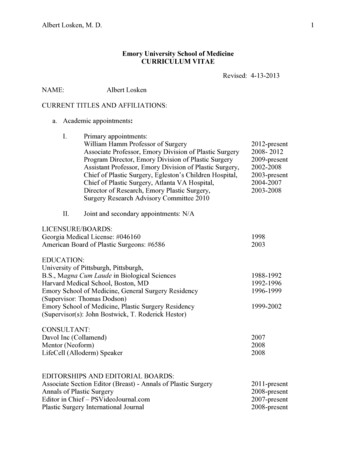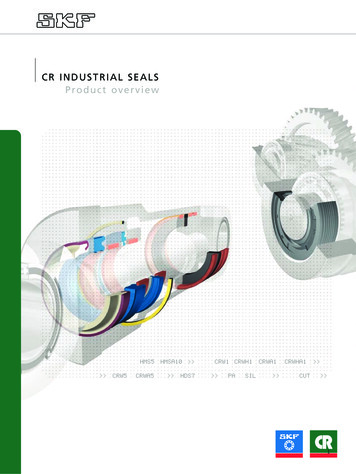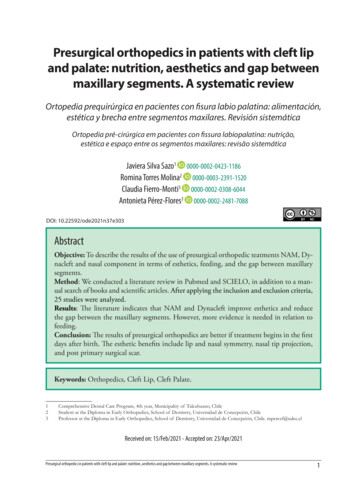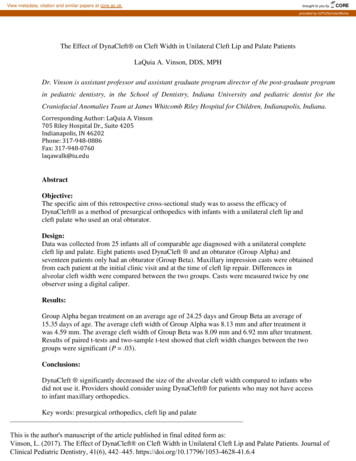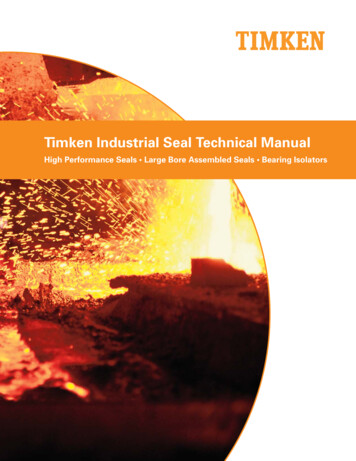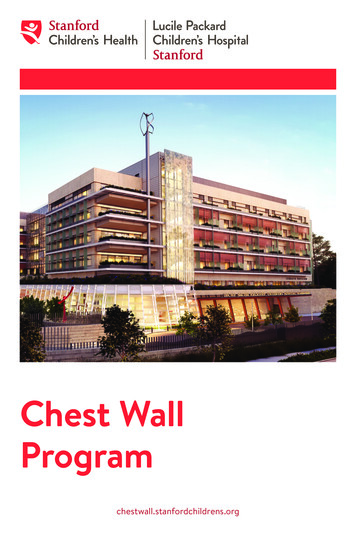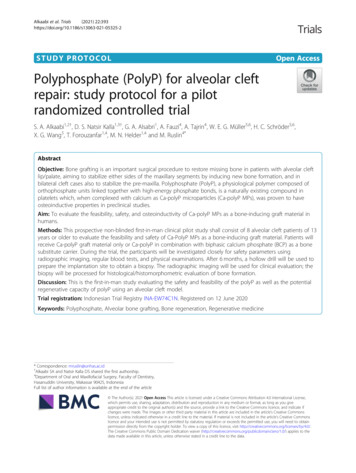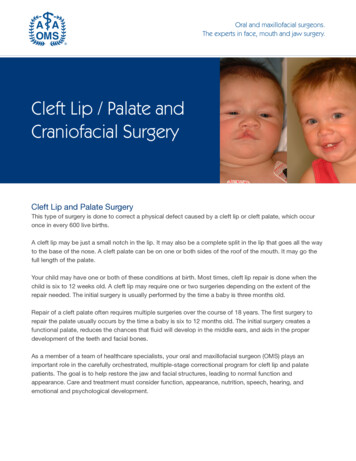
Transcription
Oral and maxillofacial surgeons.The experts in face, mouth and jaw surgery.Cleft Lip / Palate andCraniofacial SurgeryCleft Lip and Palate SurgeryThis type of surgery is done to correct a physical defect caused by a cleft lip or cleft palate, which occuronce in every 600 live births.A cleft lip may be just a small notch in the lip. It may also be a complete split in the lip that goes all the wayto the base of the nose. A cleft palate can be on one or both sides of the roof of the mouth. It may go thefull length of the palate.Your child may have one or both of these conditions at birth. Most times, cleft lip repair is done when thechild is six to 12 weeks old. A cleft lip may require one or two surgeries depending on the extent of therepair needed. The initial surgery is usually performed by the time a baby is three months old.Repair of a cleft palate often requires multiple surgeries over the course of 18 years. The first surgery torepair the palate usually occurs by the time a baby is six to 12 months old. The initial surgery creates afunctional palate, reduces the chances that fluid will develop in the middle ears, and aids in the properdevelopment of the teeth and facial bones.As a member of a team of healthcare specialists, your oral and maxillofacial surgeon (OMS) plays animportant role in the carefully orchestrated, multiple-stage correctional program for cleft lip and palatepatients. The goal is to help restore the jaw and facial structures, leading to normal function andappearance. Care and treatment must consider function, appearance, nutrition, speech, hearing, andemotional and psychological development.
About the SurgerySurgery can result in significant improvement in your child’s appearance, quality of life, and ability to eat,breathe and talk. Possible risks of surgery include bleeding, infection, poor healing, puckering of scars, andtemporary or permanent damage to nerves, blood vessels or other structures.For cleft lip surgery, your child will have general anesthesia (asleep and not feeling pain). The surgeon willtrim the tissues and sew the lip together. The stitches will be very small so that the scar is as small as possible.Most of the stitches will absorb into the tissue as the scar heals, so they will not have to be removed later.Most times, cleft palate repair is done when the child is older, between nine months and one year old. Thisallows the palate to change as the baby grows. Doing the repair when the child is this age will help preventfurther speech problems as the child develops.In cleft palate repair, your child will have general anesthesia (asleep and not feeling pain). Tissue from theroof of the mouth may be moved over to cover the soft palate. Sometimes a child will need more than onesurgery to close the palate. Ear tubes also may be placed during the first surgery to reduce the risk offrequent ear infections, which can lead to hearing loss. Ear tube surgery involves placing tiny cylinders in theeardrum to prevent fluid buildup.During these procedures, the surgeon may also need to repair the tip of your child’s nose. This surgery iscalled rhinoplasty.Your doctors may recommend additional treatment for complications caused by cleft lip and cleft palate.Additional treatments may include: Surgery to correct bone growth and/of the connection between the mouth and nose Hearing aids or other assistive devices for a child with hearing loss Speech therapy to correct difficulty with speaking Therapy with a psychologist to help a child cope with the stress of repeated medical proceduresBefore the ProcedureYou will meet with a speech therapist or feeding therapist soon after your child is born. The therapist willhelp you find the best way to feed your child before the surgery. Your child must gain weight and be healthybefore surgery.Your child’s surgeon may: Test your child’s blood (do a complete blood count and “type and cross” to check your child’s blood type) Take a complete medical history of your child Do a complete physical examination of your childAlways tell your child’s doctor, OMS or nurse what drugs you are giving your child. Include drugs, herbs andvitamins you bought without a prescription.About 10 days before the surgery, you will be asked to stop giving your child aspirin, ibuprofen (Advil, Motrin),warfarin (Coumadin) and any other drugs that make it hard for your child’s blood to clot.Ask your child’s doctor or OMS which drugs the child should still take on the day of the surgery.
Usually, on the day of the surgery, your child will not be able to drink or eat anything for several hoursbefore the procedure. You can, however, give your child a small sip of water with any drugs your medicalteam told you to give your child.You’ll be told when to arrive for the surgery. Your medical team will make sure your child is healthy. If yourchild is ill, surgery may be delayed.After the ProcedureYour child will probably be in the hospital for five to seven days right after surgery. Complete recovery cantake up to four weeks.The surgery wound must be kept very clean as it heals. It must not be stretched or have any pressure puton it for three to four weeks. Your child’s nurse should show you how to take care of the wound. You’ll needto clean it with soap and water or a special cleaning liquid, and keep it moist with ointment.Until the wound heals, your child will be on a liquid diet. Your child will probably have to wear arm cuffs orsplints to prevent picking at the wound. It is important for your child not to put hands or toys in the mouth.Most babies heal without problems. How your child will look after healing often depends on how serious thedefect was. Your child might need another surgery to fix the scar from the surgery wound.A child who had a cleft palate repair may need to see a dentist or orthodontist. The teeth may need correctingas they come in.Hearing problems are common in children with cleft lip or cleft palate. Your child should have a hearing testearly on, and it should be repeated over time.Your child may still have problems with speech after the surgery. This is caused by muscle problems in thepalate. Speech therapy will help your child.Some children may also need psychological treatment due to the stress associated with the surgery.If you have any questions at any time and at any point in the process – before, during and after surgery –make sure you ask your doctor, OMS or nurse.Craniofacial AnomaliesCraniosynostosisCraniosynostosis is a birth defect in which one or more of the joints between the bones of a baby’s skullclose prematurely, before the baby’s brain is fully formed. Treating craniosynostosis usually involves surgeryto separate the fused bones. If there is no underlying brain abnormality, the surgery allows a baby’s brainadequate space to grow and develop.Sagittal SynostosisSagittal synostosis accounts for about 50% of all synostosis cases. Premature fusion of the sagittalsuture restricts the growth of the skull, which results in an increased skull length to accommodatethe growing brain. Sagittal synostosis treatment may involve reconstruction and reshaping to normalizethe anatomy and expand the volume of the intracranial space.
Metopic SynostosisThe second most common single suture fusion is Metopic Synostosis, which occurs when the suturein the midline of the forehead fuses. Treatment involves surgery to reshape the forehead and orbital rims,and expand the volume of the intracranial space.Coronal SynostosisThere are two types of coronal synostosis. Unicoronal synostosis leads to a flattening of the forehead.Bilateral coronal synostosis results in a tall, wide and flat forehead.Lambdoid SynostosisThe rarest of premature suture fusions is the lambdoid suture synostosis, which can result in theflattening of the back of the head. Surgery reshapes the area to allow proper intracranial space.Complex CraniosynostosisComplex craniosynostosis is the fusion of multiple cranial sutures.Complex Craniofacial ProblemsChildren with craniofacial problems often require complex, long-term surgical and medical care. Somecomplex craniofacial conditions include:Apert Syndrome, which is characterized by craniosynostosis, midface deficiency, fusion of fingersor toes, and other abnormalities.Crouzon Syndrome, which is characterized by craniosynostosis, maxillary hypoplasia, shallow orbits,and a bulging eye.Pfeiffer Syndrome, which is characterized by craniosynostosis, midface deficiency, broad thumbsand/or great toes, and other anomalies.Saethre-Chotzen Syndrome, which is characterized by a misshaped head, low-set frontal hairline,facial asymmetry, deviated nasal septum, and various skeletal anomalies.Treacher Collins Syndrome is a congenital disorder characterized by down-slanting eyes,underdeveloped or absent cheekbones, small lower jaw, small or unusually formed ears, and cleftpalate. It is usually diagnosed at birth by the appearance of the infant. A prenatal ultrasound can showthe facial features typical of a child with Treacher Collins syndrome. Children with Treacher CollinsSyndrome should be evaluated by an experienced, interdisciplinary craniofacial team. No singlespecialist can manage patients with this condition, and treatment usually involves doctors who specializein many areas. Depending on the severity of the disorder, a child may require one or more surgeries,which the craniofacial team will discuss with you.Pierre Robin SequencePierre Robin Sequence is a rare congenital condition in which an infant has a smaller-than-normal lower jawwhich can cause difficulty breathing and feeding. Some patients also have a cleft palate. In addition to thesephysical characteristics, a child may have breathing problems, feeding problems in infancy, cleft palate, earinfections and hearing loss. Depending on the severity of the disorder, a child may require surgery and othertreatments. The craniofacial team can discuss these treatments with you.
Endoscopic SurgerySome types of craniosynostosis respond to alternative treatment options such as endoscopic surgery.Surgery may be performed through a small incision in the scalp, requiring no immediate reconstructionor reshaping of the bone. Following surgery a custom helmet is fabricated to mold the skull, which maytake up to a year.Any child with a head or orbital abnormality should be evaluated by a specialist. Parents should ask theirpediatrician about any concerns and proceed with the appropriate referral to either see a craniofacial surgeonor a pediatric neurosurgeon.The information provided here is not intended as a substitute for professional medical advice, diagnosis, or treatment. It is provided to help youcommunicate effectively with your oral and maxillofacial surgeon. Always seek the advice of your oral and maxillofacial surgeon regarding an oralhealth concern.The American Association of Oral and Maxillofacial Surgeons (AAOMS), the professional organization representing more than 9,000 oral andmaxillofacial surgeons in the United States, supports its members’ ability to practice their specialty through education, research and advocacy.AAOMS members comply with rigorous continuing education requirements and submit to periodic office examinations, ensuring the public that alloffice procedures and personnel meet stringent national standards.American Association of Oral and Maxillofacial SurgeonsAmerican Association of Oral and Maxillofacial Surgeons97009700 WestWest BrynBryn MawrMawr Ave,Ave, Rosemont,Rosemont, IllinoisIllinois .847.678.6286IP. 847.678.6200 or 800.822.6637 I F. 847.678.6286 I www.myoms.orgwww.myoms.org2005-2013 American Association of Oral and Maxillofacial Surgeons (AAOMS). All rights reserved. 2005-2015
For cleft lip surgery, your child will have general anesthesia (asleep and not feeling pain). The surgeon will trim the tissues and sew the lip together. The stitches will be very small so that the scar is as small as possible. Most of the stitches will absorb into the tissue as the scar heals, so they will not have to be removed later.

